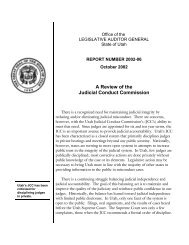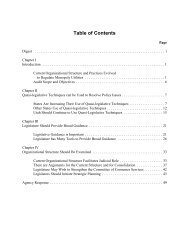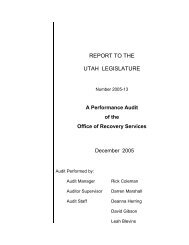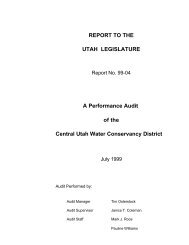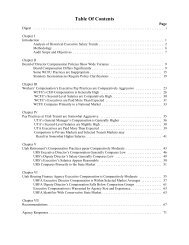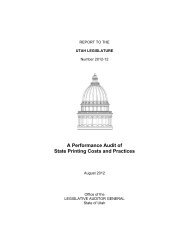A Performance Audit of the Utah Telecommunication Open ...
A Performance Audit of the Utah Telecommunication Open ...
A Performance Audit of the Utah Telecommunication Open ...
You also want an ePaper? Increase the reach of your titles
YUMPU automatically turns print PDFs into web optimized ePapers that Google loves.
plan did not anticipate <strong>the</strong> difficulty UTOPIA would face in resolvingright-<strong>of</strong>-way disputes. These mistakes were costly and contributed to<strong>the</strong> delayed completion <strong>of</strong> <strong>the</strong> project.We believe an underlying problem throughout UTOPIA’sexpansion is <strong>the</strong> lack <strong>of</strong> a carefully prepared development plan andpolicies to guide <strong>the</strong> construction <strong>of</strong> <strong>the</strong> network. When we asked tosee <strong>the</strong> original planning document for UTOPIA’s expansion, staffwere unable to produce one. They said <strong>the</strong> planning <strong>of</strong> <strong>the</strong> networkwas initially carried out by UTOPIA’s contractor, Dynamic City, andthat <strong>the</strong>y may or may not have had a written plan. However, if itexisted, no copy was on record at UTOPIA’s main <strong>of</strong>fices. We wouldfind it alarming if a government entity attempted such a highlycomplex and expensive construction project without drafting a formalwritten plan approved by a governing board. However, board minutesmake no mention <strong>of</strong> <strong>the</strong> board ever reviewing and approving such adocument and staff report that no such document is on file.The Decision to Build in Many Cities Simultaneously Was aMistake. UTOPIA board and staff commonly identified as onemistake <strong>the</strong> decision to attempt a “ubiquitous build.” That is, <strong>the</strong>agency attempted to build at least a portion <strong>of</strong> its networkinfrastructure in each <strong>of</strong> its member cities at <strong>the</strong> same time. Thisapproach to construction led to partially completed sections <strong>of</strong>network in multiple cities at different locations that are still incapable<strong>of</strong> producing revenue.At first, UTOPIA intended to complete construction <strong>of</strong> <strong>the</strong>network in a few construction areas or footprints at a time. Inaddition, <strong>the</strong> initial strategy focused on locations that were expected toprovide a high initial return on investment. Once an area wascompleted, UTOPIA could enroll subscribers and immediately begingenerating <strong>the</strong> revenue needed to build in o<strong>the</strong>r locations.Citing politicalpressures, UTOPIAleadership altered itsbuild strategy toappear moredemographicallyinclusive.One consultant, who worked with UTOPIA from <strong>the</strong> beginning,told us that political pressure led <strong>the</strong>m to adopt <strong>the</strong> strategy whereby<strong>the</strong>y would build portions <strong>of</strong> <strong>the</strong> network in many differentcommunities at once. In 2007, a year after <strong>the</strong> agency completed itsfirst phase <strong>of</strong> construction, UTOPIA was accused <strong>of</strong> abandoning itscommitment to universal service. Instead, its critics said, <strong>the</strong> agencywas focused exclusively on wealthier neighborhoods and was “cherrypicking” <strong>the</strong> high-end subscribers.- 24 -A <strong>Performance</strong> <strong>Audit</strong> <strong>of</strong> <strong>the</strong> <strong>Utah</strong> <strong>Telecommunication</strong> <strong>Open</strong> Infrastructure Agency (August 2012)



